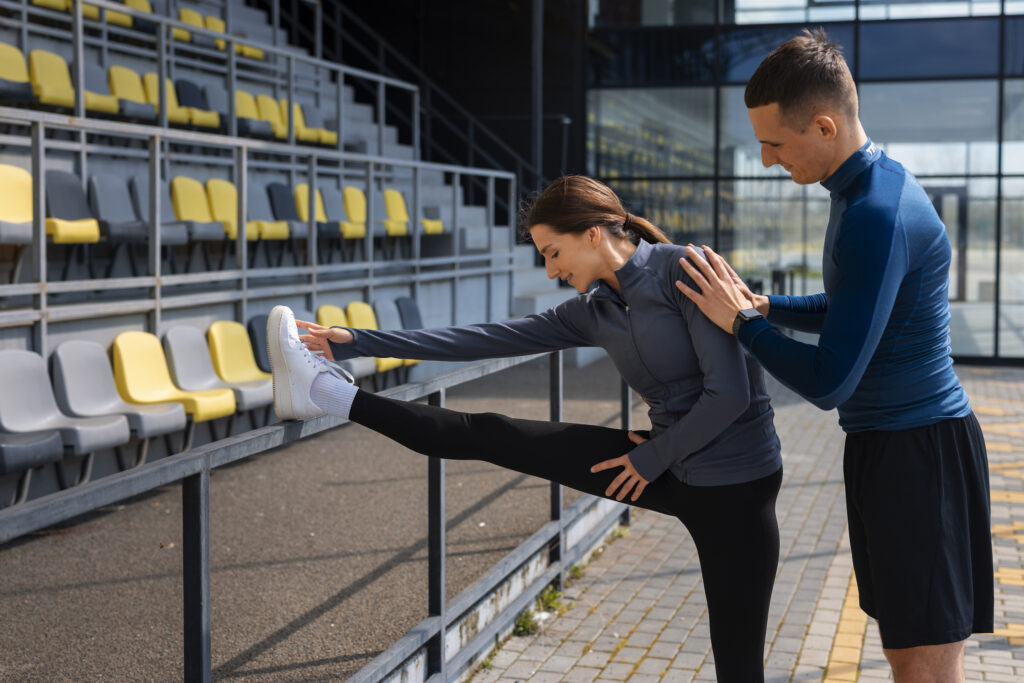
Athlete warming up under professional guidance during college sports training.
Every athlete dreams of improving performance, gaining recognition, and building a future through sports. But behind every success story lies structured effort, smart guidance, and continuous learning. That’s where sports performance training plays a defining role. It not only shapes physical skills but also nurtures mental strength, discipline, and focus. These qualities eventually open the door to rewarding careers for athletes, whether they continue playing or move into coaching, sports management, or fitness education.
For many, the transition from playing fields to professional growth can be confusing. Questions like “How do I train right?” or “What can I do after my sports career?” often arise. The answer begins with a strong foundation built through well-designed performance training programs that teach athletes how to train efficiently, recover properly, and develop a winning mindset.
Understanding What Sports Performance Training Means
Sports performance training is more than physical exercise. It’s a complete system that improves how an athlete moves, reacts, and performs under pressure. The training focuses on improving strength, endurance, flexibility, agility, and power while also teaching recovery and injury prevention.
A good program begins by identifying the athlete’s strengths and weaknesses. Whether it’s a football player working on explosive sprints or a swimmer improving breathing control, training must match the sport’s specific demands. This approach maximizes progress and reduces wasted effort.
Beyond physical benefits, sports performance training builds mental focus. It prepares athletes to stay calm during high-pressure moments and make smart decisions quickly. Over time, it transforms raw talent into consistent excellence.
Why Every Athlete Needs Structured Training
Some athletes rely only on natural ability. But talent alone can’t sustain long-term performance. Structured training programs provide direction, purpose, and measurable improvement. With the right balance of physical conditioning, recovery, and goal setting, athletes can sustain peak performance year-round.
A well-structured sports performance training plan helps in several ways:
- It increases agility, speed, and coordination through sport-specific drills.
- It builds stronger muscles and better balance to avoid injuries.
- It teaches efficient breathing and movement patterns for endurance.
- It emphasizes recovery strategies to maintain long-term fitness.
- It builds mental confidence to perform under any circumstance.
When athletes follow personalized and science-backed programs, they begin to see results that last beyond the playing field. This consistency creates the base for growth, recognition, and even scholarship opportunities in colleges and universities.
Core Components of Sports Performance Training
1. Strength and Conditioning
Building core strength supports every athletic movement. Strength training includes weightlifting, resistance bands, and stability exercises that target different muscle groups. This not only increases power but also stabilizes joints, reducing the risk of common sports injuries.
2. Speed and Agility Work
Speed is often the deciding factor in competitive sports. Through sprint drills, footwork exercises, and agility ladder training, athletes can improve their reaction time and movement precision.
3. Flexibility and Mobility
Stretching and mobility drills keep muscles loose and joints healthy. They improve performance and prevent strain during high-intensity activities.
4. Nutrition and Hydration
Proper nutrition fuels the body for training and recovery. Balanced meals rich in proteins, carbohydrates, and healthy fats are essential. Hydration maintains energy levels and improves focus.
5. Recovery and Rest
Rest days are not wasted days. They are when the body repairs and grows stronger. Techniques like foam rolling, massage, and sleep optimization speed up recovery.
6. Mental Training
Confidence and composure define great athletes. Visualization, mindfulness, and goal-setting help develop mental resilience that complements physical ability.
Sports Performance Training and Scholarships
Many colleges across the world value students who show commitment to training. Sports performance training can directly improve an athlete’s chances of earning a scholarship. Coaches look for discipline, measurable improvement, and consistency.
Students who train properly present stronger profiles during recruitment. They not only perform better but also show maturity, leadership, and focus — qualities that scholarship programs reward.
This path helps athletes combine education with sport, reducing financial pressure while gaining valuable life experience. It’s a stepping stone to both personal and professional growth.
Building Long-Term Careers for Athletes
Every athlete eventually faces a transition point — from competitive play to broader career opportunities. With a background in sports performance, there are countless careers for athletes beyond the field.
1. Sports Coaching and Mentorship
Athletes who have trained extensively understand the discipline and structure required to succeed. They can guide young athletes as coaches or mentors. Their firsthand experience gives them credibility and insight.
2. Fitness and Strength Training
Certified trainers and performance coaches are always in demand. Athletes with a strong understanding of conditioning and recovery can easily move into fitness instruction or gym management roles.
3. Sports Management and Administration
For those who enjoy organization and strategy, managing sports events, teams, or academies can be fulfilling. This field requires leadership, communication, and problem-solving — skills that athletes naturally develop.
4. Physiotherapy and Athletic Therapy
Some athletes transition into sports medicine and rehabilitation. They use their knowledge of body mechanics to help others recover from injuries and perform better.
5. Brand Ambassadorship and Media Opportunities
Today, many athletes build personal brands. They collaborate with sportswear companies, fitness platforms, and health products. Others become commentators or analysts, sharing their experience and insight with audiences worldwide.
Each of these paths allows athletes to continue contributing to sports while shaping their professional identity. The lessons learned from sports performance training — discipline, teamwork, consistency, and mental focus — are valuable across all fields.
The Role of Consistency and Self-Awareness
Training consistency is what separates good athletes from great ones. Regular effort builds physical endurance and mental sharpness. It’s not about training harder every day but training smarter. Tracking progress, listening to the body, and staying adaptable keeps improvement steady and sustainable.
Self-awareness also plays a big role. Knowing when to push limits and when to rest prevents burnout and injuries. Athletes who understand their body’s signals are better prepared for long-term success.
How to Choose the Right Performance Program
Not all programs deliver the same results. The right sports performance training center or coach should offer:
- Personalized assessments and goal setting
- Focus on form, function, and balance
- Data-based progress tracking
- Recovery and nutrition support
- Mentorship from experienced professionals
Working with certified trainers ensures that training remains effective and safe. Good programs adapt as athletes grow, ensuring continuous improvement.
The Future of Sports Performance and Athlete Careers
The demand for qualified athletes and performance specialists is growing worldwide. With technology and sports science advancing rapidly, athletes today have access to tools that were once available only to professionals. Motion tracking, wearable fitness devices, and AI-based analytics make it easier to monitor performance and recovery.
These advancements are creating more specialized careers for athletes — from sports data analysis to biomechanics consulting. Athletes who combine practical experience with academic knowledge will continue to lead in this field.
Conclusion
Sports success doesn’t happen overnight. It’s built through discipline, patience, and proper guidance. Sports performance training helps athletes build stronger bodies, sharper minds, and smarter habits. It’s the bridge between raw talent and lasting achievement.
When athletes focus on structured training and continuous growth, they open doors to a lifetime of opportunity. Whether it’s through professional play, coaching, management, or fitness careers, the lessons learned through sports become valuable skills for life.
For aspiring athletes, this is the time to invest in training, stay committed, and create a strong foundation for both personal growth and future success.



